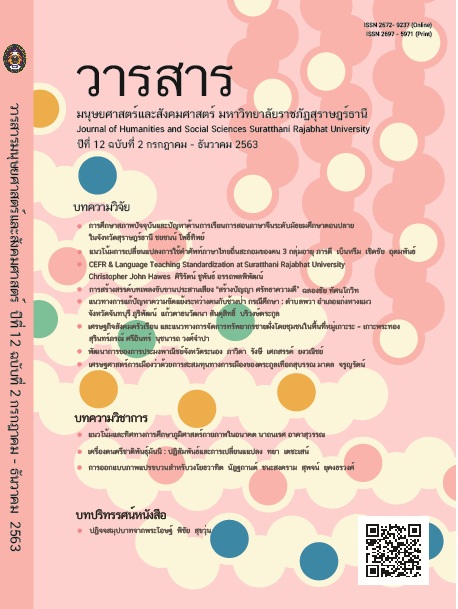Guidelines for solving conflicts between human and wild elephants A Case study: Phawa Sub-district, Kaeng Hang Maeo District, Chanthaburi
Main Article Content
Abstract
This research aims to analyze the causes of conflicts betweenhumans and wild elephants, And study the guidelines for sustainablecoexistence between people and wild elephants in Phawa Sub-district Kaeng Hang Maeo District Chanthaburi Province Which is an analysis That uses a Qualitative research approach that uses an in-depth interviewmethod with Questionnaires as a tool for collecting data from two groups of data providers which are group 1 community leaders in the area having problems from wild elephants invading and destroying agricultural crops in 5 villages, groups 2 Farmers groups affected by the destruction of wildelephants by agricultural crops in the year 2562 in every household, totaling 20 households, in order to collect the data collected and summarize by analytical descriptive. The study found that Factors that cause conflictbetween humans and wild elephants In the area of Phawa Sub-district Kaeng Hang Maeo District Chanthaburi province is a population increase in the Phawa community during the period 1994 - 2019, with an increase of more than 60 percent, causing encroachment of forest areas to expandarable land, resulting in Further reducing the forest that is the natural habitat of elephants, causing wild elephants to search for food outside of the forest. And the way of life of the people in the Phawa community according to the capitalist economic system which spread within the community resulting from the development of public utilities of the government agencies,resulting in the way of life of the people of the community to change Changed from relying on natural resources as a traditional way of life To the necessity of production factors Living from outside causes the people of Phawa community to earn money which is the main factor. In shopping for consumer goods Consuming makes it necessary to make use of the forest, which inevitably affects encounters between humans and elephants. As for the ways to solve conflicts between people and wild elephants Can bedivided into 3 main ways as follows.1) Urgent or immediate solutions to problems such as setting up surveillance and evacuation missions and the fast-moving operating setPatrol the area and advise the people as well as help to solve the situation
2) Medium-term, for example, to construct ditches to protect wild elephants at precarious spots on routes that people and students useregularly. In order to prevent the elephants from attacking and planting more bamboo bamboos with thorns along the elephant barrier Prepare an electric fence By coordinating with the village headman - the village headman Consider the area of a fruit orchard where elephants regularly come to eat the crops. Organize a set of operations to give knowledge on how to protect wild elephants.3) Long-term consist of 4 ways as follows: (1) Creating a positiveattitude to coexist between humans and wild elephants (2) Modifyingagriculture practices around areas where wild elephants live (3) Should
improve Government regulations by the Department of Disaster Prevention and Mitigation There must be clear and quick guidelines for providing
assistance when people are injured or killed by wild elephants or ifagricultural crops are damaged or destroyed.
(4) Coordinate with agencies from the Ministry of Natural Resources and Environment to find ways to move wild elephants away when there is an increase in the amount of food sources which are insufficient. And move to find a place for a new wild elephant for the ferocious wild elephant to endanger the new area especially for the ferocious wild elephant.
Article Details

This work is licensed under a Creative Commons Attribution-NonCommercial-NoDerivatives 4.0 International License.
All published manuscripts have been verified by peer-peer professors in the fields of humanities and social sciences. Reprinting of the article must be authorized by the editorial staff.
References
กรมอุทยานแห่งชาติ สัตว์ป่า และพันธ์พืช. (2561). แผนการจัดการช้างป่า พ.ศ.2561-
(20 ปี) ฉบับแก้ไข พ.ศ.2561. กรุงเทพฯ : กลุ่มงานบริการวิชาการ กรม
อุทยานแห่งชาติ สัตว์ป่า และพันธ์พืช กระทรวงทรัพยากรธรรมชาติและ
สิ่งแวดล้อม.
จังหวัดจันทบุรี. (16 มกราคม 2558). ประกาศจังหวัดจันทบุรี เรื่องประกาศเขตการให้
ความช่วยเหลือผู้ประสบภัยพิบัติกรณีฉุกเฉิน (ช้างป่าทำร้ายราษฎรบาดเจ็บและ
ทำลายทรัพย์สินและพืชผลทางการเกษตรเสียหาย) ในพื้นที่อำเภอแก่งทางแมว
จังหวัดจันทบุรี.
นพพร อังศุโชติ. (2551). การศึกษาแนวทางการบรรเทาปัญหาความขัดแย้งระหว่างคน
กับช้างป่า: กรณีศึกษาตำบลวังด้ง อำเภอเมือง จังหวัดกาญจนบุรี. วิทยานิพนธ์
วศ.ม. บัณฑิตวิทยาลัย มหาวิทยาลัยมหิดล.
พันทิภา พัฒนแก้ว. (2550). เทคนิคการจัดการปัญหาความขัดแย้งระหว่างคนกับช้าง.
นนทบุรี : สมาคมอนุรักสัตว์ป่าและกรมอุทยานแห่งชาติ สัตว์ป่าและพันธ์พืช.
วิวัฒน์ สุภาพ. (2558). การแก้ไขปัญหาช้างป่าในพื้นที่อำเภอแก่งหางแมว. จันทบุรี :
สมาคมอนุรักษ์สัตว์ป่า. (2550). ทำการศึกษาเพื่อแก้ปัญหาความขัดแย้งระหว่าง
คนกับช้างบริเวณอุทยานแห่งชาติแก่งกระจาน. เพชรบุรี : สมาคมอนุรักสัตว์ป่า
และอุทยานแห่งชาติแก่งกระจาน.
.(2550 ก). เทคนิคการจัดการปัญหาความขัดแย้งระหว่างคนกับช้าง. กรุงเทพฯ :
แสงเมืองการพิมพ์.
ไสว วังหงษา. (2547). ประชากรและโครงสร้างทางประชากรของช้างป่าในพื้นที่เขตรักษา
พันธ์สัตว์ป่าเขาอ่างฤาใน จังหวัดฉะเชิงเทรา สระแก้ว จันทบุรี ระยอง และ
ชลบุรี. ฉะเชิงเทรา:สถานีวิจัยสัตว์ป่าฉะเชิงเทรา กรมอุทยานแห่งชาติสัตว์ป่า
และพันธุ์พืช.
ไสว วังหงษา. (2551). การจัดการปัญหาระหว่างคนกับช้างป่าในผืนป่าภาคตะวันออก.
กรุงเทพฯ:สำนักอนุรักษ์สัตว์ป่า.
อดิสร เหมทานนท์. (2547). ปัจจัยที่มีความสัมพันธ์กับอุปสงค์ที่มีต่อไม้ไผ่ของราษฎร ที่
อาศัยอยู่รอบเขตรักษาพันธุ์สัตว์ป่าสลักพระ จังหวัดกาญจนบุรี. วิทยานิพนธ์
วศ. ม.บัณฑิตวิทยาลัย มหาวิทยาลัยเกษตรศาสตร์.


